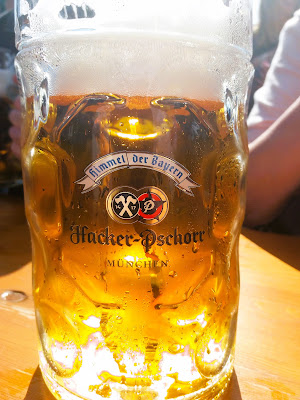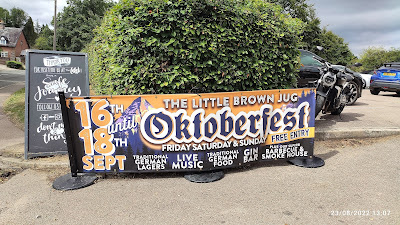It’s been a rather frustrating week since completing my walk along the final section of the North Downs Way. My elation at completing this long-distance footpath, was tempered somewhat, by an issue with our recently upgraded central heating system – teething issues, with any luck, plus a recent internet outage at home. The heating engineer is due a return visit today, and as far as the internet issue is concerned, BT Openreach, or whatever they call themselves these days, are due to upgrade our connection, and router, to full-fibre broadband next Thursday. The latter, sounds like a breakfast cereal, but the new system broadband connection should offer faster speeds and more reliability. To be fair, we haven’t suffered too much with connectivity issues, and as none of us are avid film buffs, we do very little in the way of streaming, so we shall see how the upgrade affects us, but whilst on the subject of upgrades and boosters, Mrs PBT’s and I had our second Covid booster (4th vaccine dose) last Saturday, along with the latest flu vaccine. It was literally a shot in each arm, and whilst we both felt OK on the day, Sunday ended up as a total washout, as far as doing anything constructive was concerned. I’m not sure which of the vaccines produced the headaches, aching limbs and associated cold and flu symptoms, but I suspect it was a combination of the two, but fortunately I at least felt alright to return to work, as usual, on Monday morning. Still, no gain without the pain, as the saying goes, but I don’t like having to waste a day, as what happened that Sunday. I did manage to complete that lengthy article on Oktoberfest for the blog, and there are another few articles still in my head that I need to write up, but it’s amazing how relatively minor technology problems can have such a disruptive effect on everyday activities. First world problems, of course, so what’s coming up next in the world of beer and travel? Thursday evening (tonight) should see a group of us meeting up at the Nelson Arms in Tonbridge, for an informal sampling of the Green Hop Ales that are on sale at the pub. There will also be the opportunity to sample a green hop ale, brewed by a local CAMRA member who is a keen and very prolific home-brewer. The beer will be brewed using hops freshly harvested, from another member’s garden. The latter has a very healthy-looking hop-bine growing up the side of the house, and having seen the photos, it was laden with plenty of attractive looking hops cones. To my shame, I have yet to sample any of this year’s crop of green hop ales, so am looking forward to getting stuck into a few on Thursday evening, including the home-grown and home-brewed example! On the walking/hiking front, I’ve still to complete the two short sections of the North Downs Way – the ones I described in some detail, in the previous article. As explained, for reasons of expediency, I deviated slightly from the official trail with these sections, and took a slightly different, and less strenuous route. Today, Matthew and I were due to complete the stretch of downland above Folkestone – the one with the delightful view overlooking the Channel Tunnel Terminal, but with rain forecast, and the heating engineer expected, that’s had to be postponed. There’s no rush of course, to complete such things, although it would be nice to have then out of the way by the end of the year. This leads on to what waking trail should I complete next? I’m tempted to stay local and give the Tunbridge Wells Circular Walk a try. On my visit to Cranbrook back in February, I picked up a guide from Larkin’s Alehouse to this 27.5-mile trail which, as its name suggests, is a route around the rural periphery of Tunbridge Wells. The route passes through the High Weald Area of Outstanding Natural Beauty and allows walkers to enjoy the undulating countryside of the High Weald, a landscape of patchwork fields, broad-leaved woodland, and parkland. On its way, it takes in the villages of Southborough, Pembury, Frant, Groombridge and Speldhurst. Although I seem to have mislaid it, the book I purchased, describes four shorter circular walks, using fully waymarked link routes. These walks are stand alone, but they do intersect with the main route at certain points along the way. Each walk starts in the centre of Tunbridge Wells within easy reach of the railway station and local bus services, and for those who are familiar with the area, they are the Southborough Circular, the Pembury Circular, the Sussex Circular and the Speldhurst Circular, each highlighting distinctive areas of the attractive Wealden countryside.
I haven’t looked at any of these walks in detail (I need to find the book first), but I know from past experience that I have already walked several sections of the main route. Coupled with the aforementioned “bolt-ons” there should be plenty of opportunity for heading out into the countryside, during the winter months, without straying too far from home. I am also sure there will be ample opportunities for pub visits, along the way!
The other walking project is more suited to spring or summer, especially as it involves quite a bit of planning. It is also much further away, in the Cotswold Hills of Gloucestershire and Oxfordshire. “The Donnington Way” is a series of walks between all 15 inns belonging to the Donnington Brewery, covering a total distance of 62 miles. I have legendary pub man, Stafford Paul to thank, for alerting me to this one, as Paul undertook the walk several years ago, and recorded his enjoyment of it, in the form of comments on several blogs. I duly sent off for the book which acts as a guide to both the 15 pubs, and how to get from one to another, all on foot. The book was written, researched, and photographed by Colin Handy, with maps and illustrations by Peter T Reardon. The first edition was published in 1991, but with a 4th edition appearing in 2012, the guide has been re-walked and fully revised.The book lists 15 pubs, although the Donnington website states that there are 19, so presumably under its current owners, Peter and James Arkell, the brewery must have expanded. Peter and James inherited the brewery, following the death of their cousin Claude Arkell, in 2007. The company passed to them, as Claude Arkell had no children, and I’m pretty certain he had no spouse either. Peter and James of course have their own family-owned brewery, Arkells Ltd of Swindon, a reasonably sized concern owning around 100 pubs.
So far as practicalities are concerned, several of the pubs are quite close together, but then there are others where the distances between them are far greater. The planning for even attempting this trail hasn’t even approached the serious stage yet, but the sensible approach would be to incorporate any overnight stops at those pubs which offer accommodation. As might be expected, the pubs offering B&B don’t always tie in nicely with some of those at the end of the next stretch, and when that happens to be a lengthy one, then that particular option falls to pieces.There are others of course, but they will probably involve pitching up at a non-Donnington owned establishment that does offer a bed for the night. So not an insurmountable problem, but one that still needs careful thought and proper investigation. Regardless of what happens, walking the “Donnington Way,” would not be my first attempt to visit every Donnington owned and run pub. In June 1983, I embarked on a cycling holiday in the Cotswolds. The idea was to cycle around visiting all the pubs belonging to Donnington brewery, and there were 17 of them at the time.
You can read about my adventures by clicking on to my now virtually defunct blog page, Paul’s Beer Travels. This is not the same site as the website I set up nearly 30 months ago, and the one I eventually allowed to lapse. Without giving too much away, the cycling and camping trip was undertaken by myself and the previous Mrs Bailey, and despite our best endeavours, we only managed 8 out of the 17 pubs.This was over a five-and-a-half-day period, and was before the days of all day opening, and the internet. We had trouble locating suitable campsites, relying in the end on word of mouth – often, the most reliable. Despite visiting in June, the weather was at times, quite cold and miserable. Strong headwinds often made cycling difficult, so with that in mind, and the fact that 40 years have elapsed since then, I’m more than content to complete the task on foot.
I shall of course, start from scratch, rather than carrying on from where I finished before. The experience is more complete that way, and besides it will be interesting to see whether re-visiting those 8 pubs from 1983, will bring back a few memories, or will some have been altered out of all recognition?
Footnote: Unfortunately, there are few photos from that 1983 cycling trip. I probably have some old prints, or transparencies, tucked away somewhere, but even if I do lay my hands on them, they will require scanning in order to convert then to a digital format. Instead, I’m afraid, you will either have to use your imagination, or take a look on the Donnington website.
Unfortunately, my heating is still playing up, despite two call-outs that were supposed to have fixed the problem, - hence the title of this post!





























